Posted by Kristen Goodhue on June 8th, 2012
by Kristen Minogue
Mysterious things happen to forests as they grow old. The passing of time alters the trees, the animals, the microbes, even how much they breathe.
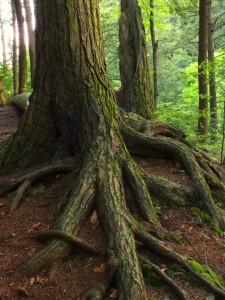
Hemlock tree in Salt Springs State Park, Penn. Hemlocks are one of the last trees to populate a forest, and those forests seem to be better at storing carbon. (Nicholas_T)
Just like people, forests age. Dense rows of birch and cherry trees give way to tulip poplars. Eventually the tulip poplars vanish and more spacious oaks and hemlocks rise up in their place. But arguably the most important changes occur underground. The planet’s soils store
more than three times as much carbon as the atmosphere. And—while researchers still aren’t sure exactly why—older forests seem to be better at holding onto it.
Click to continue »
Posted in Climate Change, Ecology | Comments Off on Aging Forests Better at Trapping Carbon
Posted by Kristen Goodhue on June 6th, 2012
by Dan Gruner

Black mangrove. Mangroves like this tolerate hot, salty environments partly by exuding excess salt onto their leaves. (John Parker)
Will
tropical mangroves take over the world?
I don’t think anyone believes that will happen. However, it does seem that mangroves are moving up in latitude, encroaching into more temperate salt marsh systems dominated by cord grass and other herbaceous species. Although mangrove systems are in steep decline worldwide because of coastal development, aquaculture and other human activities, climate change and other factors may be increasing their total geographic range.
Why would this happen? What would this mean for coastal ecosystems in the USA and globally? And what would it mean for the billions of people who live within 20 miles of a coastal zone, or the billions more who rely on some form of oceanic protein?
Click to continue »
Posted in Climate Change, Ecology, Invasive Species, Mangrove Tracking: Letters from the Field | 4 Responses »
Posted by Kristen Goodhue on May 23rd, 2012
by Monaca Noble

Arthur Carlton-Jones, the Boy Scout who encouraged fishermen to throw unused bait in the trash. (Photo: Michael Carlton-Jones)
“Free live bait!”
Those were the words that echoed out during August and early September of last year, when the Marine Invasions Lab at the Smithsonian Environmental Research Center (SERC) gave away hundreds of bags of bloodworms to Maryland fishermen. We’re doing it again this spring. Why would an environmental research center give away hundreds of dollars worth of worms?
Click to continue »
Posted in Ecology, Invasive Species | 3 Responses »
Posted by Kristen Goodhue on May 7th, 2012
by Kristen Minogue

The milky blue waters of this Iceland lagoon are teeming with cyanobacteria, also known as blue-green algae. (Marie-II)
Beneath the surface of the ocean, an invisible army of workers is fighting to keep climate change in check. Many have been silently absorbing or burying carbon for billions of years, and humanity has just begun to take notice of them. These unassuming laborers are bacteria.
Click to continue »
Posted in Climate Change, Ecology | 1 Response »
Posted by Kristen Goodhue on April 26th, 2012
It’s national Poem in Your Pocket Day, and brevity has been the soul of wit since (approximately) 1603. We’re celebrating by showcasing some of the shortest nature poems in the history of the written language.
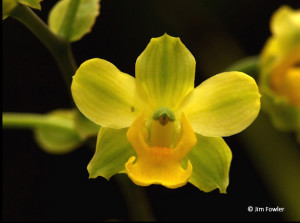
Yellow cowhorn orchid, Cyrtopodium flavum (Jim Fowler)
Nature rarer uses Yellow
Than another Hue.
Saves she all of that for Sunsets
Prodigal of Blue
Spending Scarlet, like a Woman
Yellow she affords
Only scantly and selectly
Like a Lover’s Words.
-Emily Dickinson (1830-1886)
Click to continue »
Posted in Ecology, Invasive Species | Comments Off on Top Nature Poems Under 100 Words
Posted by Kristen Goodhue on April 9th, 2012
by Samantha Reed

Photo courtesy of Samantha Reed
Posted in Classes and Events, Programs, SERC Sites and Scenes | 5 Responses »
Posted by Kristen Goodhue on April 2nd, 2012
by Kristen Minogue
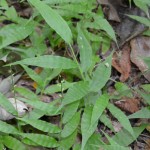
Vanessa Beauchamp/Towson University
Fourteen years ago, a green, hairy and incredibly sticky plant appeared in a Maryland park. Now it has biologists all over the state worried. But does this South Asian forest grass have what it takes to be a serious invader?
Click to continue »
Posted in Ecology, Invasive Species | 1 Response »
Posted by Kristen Goodhue on March 15th, 2012
by Kristen Minogue
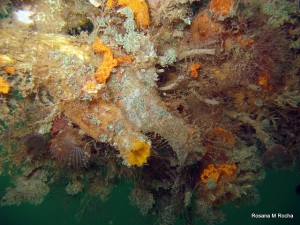
Ascidia sydneiensis. Rosana Rocha, Universidade Federal do Paraná
Tunicates. Ascidians. Filter-feeders. Sea grapes. Sea squirts. They go by many names, all describing some of the most colorful invaders in the ocean. A photo gallery from the marine invasions lab offers a glimpse of the most stunning.
Click to continue »
Posted in Ecology, Invasive Species | 3 Responses »
Posted by Kristen Goodhue on February 24th, 2012
by Kristen Minogue

Nemodus Photos
Sometimes Mother Nature completely outdoes anything we’ve created for ourselves. Accomplishments like the Agricultural and Industrial Revolutions can seem almost laughable when there are
lizards that can walk on water. When that happens, smart engineers try to take a lesson from it. It’s called biomimicry: technology inspired by nature.
Examples include gecko tape, shape-shifting airplane wings and Velcro©. Last week a group of teenage students in SERC’s home-school program finished their own research on animal physiology and brought a few more examples to our attention. Here are four ways birds and amphibians outclass humanity – and some wacky yet brilliant ways we can mimic them.
Click to continue »
Posted in Classes and Events, Ecology | 4 Responses »
Posted by Kristen Goodhue on February 7th, 2012
by Monaca Noble
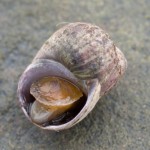
Invasion was a godsend for the rough periwinkle snail, which managed to escape its flatworm parasites. (World Register of Marine Species)
Most organisms have several types of parasites associated with them. However, when species are introduced, they may lose some of their natural parasites through the invasion process. Or sometimes, parasites that survive the journey don’t do very well in the new environment. In essence invasion acts as a filter limiting the number of parasites that are transported and introduced. In science this process is called the parasite escape hypothesis.
Take the common cat parasite Toxoplasma gondii. T. gondii‘s complex two-host life cycle makes it difficult for it to adapt to new places. The parasite has two phases, a sexual phase and an asexual phase. The sexual phase can only take place in the cat (primary host), but the asexual phase can occur in several mammal species (secondary host) including cats, mice, humans, and birds. Because the parasite must infect a cat to reproduce and survive, its preferred secondary host is a mouse. If a mouse infected with T. gondii were introduced into an area with no cats, the parasite would not be able to survive.
Click to continue »
Posted in Ecology, Invasive Species, Publications | Comments Off on Invaders escape persecution from parasites











